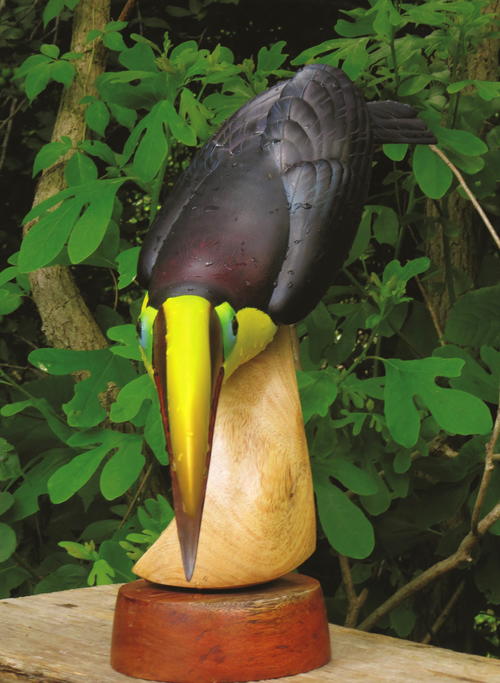A Toucan Decoy - Part 3
It's painting time!

A toucan’s flight feathers (the tail rectrices, primary and secondary remiges, and its wing coverts) look slick and smooth. This is because they have a tight barb texture. Although these flight feathers are basically sooty coal black, they also shimmer with colorful iridescence. The feathers of the dorsum, mantle, side pockets, head, and hind neck have a very open barb texture, but they still have a pale greenish-blue shimmering iridescence. In addition, the hind neck and upper mantle of the chestnutmandibled toucan display bright crimson feather barbs. The lemon-yellow chest, white rump spot, and scarlet crissum feathers also have very open barb texture. This helps the bird with heat exchange during the hot days and cold nights in the rainforest. These open-barb feathers also allow the toucan’s wet plumage to dry quickly in its wet and humid home.
I use oil paint exclusively. For this toucan I will use four brands, starting with Ronan Japan oil paints for the sealer, primer, and “grisaille” pre-painting steps. For the painting, I will use Daniel Smith iridescent oil paints, Old Holland oil colors (my preferred choice), and fast-drying Griffin alkyd paints for the black and white mixes. For the diluent thinning agent I prefer Grumbacher’s Grumtine, which produces a soft matte finish. Grumtine is a mixture of turpentine and citrus thinner and has a pleasant orange odor. I also use Grumbacher Oil Painting Medium I to thin down the paint for detailing. Because yellow and red oil paints are very slow drying, I will add a few drops of Cobalt Drier to the mixed reds and yellows to help speed up the drying time.
Paint consistency is important. Every color on the palette should have the same malleable consistency, which I compare to room-temperature butter. Oil colors from the tube vary from hard to soft. Generally, I prefer softer. If the paint comes out of the tube a little hard, I thin it slowly with the diluent. Every color on your palette must have the same soft-butter consistency. Trying to blend a hard color to a soft color will yield disastrous results. On decoys and smoothie-type carvings and sculptures, I use what I call “fat” paint, which means right out of the tube. “Lean” paints have been thinned with a diluent, and a “leaned” paint has a medium added. Alkyd oil colors generally are “hard” when squeezed from the tube. Because of the fast-drying times of alkyd paints, I use them only when they are mixed with other colors. Alkyds also dry with an “egg-shell” finish that is appealing for old decoy replicas, but not for soft-finished smoothies. To override the undesirable aspects of the alkyd paint, I use them only as a mix-mate with black and white paints. The formula that gives me the most favorable results are 50/50 alkyd to oil paint. For my whites, I use alkyd titanium white with Old Holland Cremnitz (flake) white. For the black, I mix the alkyd lampblack with the Old Holland Mars black.
Read the complete article in Wildfowl Carving Magazine's Spring 2016 issue.
Read NextEastern Bluebird, Part One



